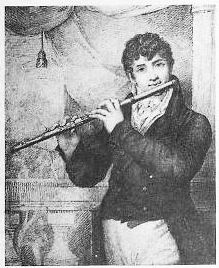

Verona-born Tebaldo Monzani (1762–1839) came to London about 1785. The firm Monzani & Co. produced a great many fine flutes from 1808 to 1829, when Monzani retired and his collaborator Henry Hill continued the business as Hill, late Monzani & Co.
Monzani's flutes differ from most English flutes in a number of ways. One might guess that he was influenced by Continental instruments more than other London makers were, but he deserves credit for many innovations. The workmanship is of very high quality, as are the materials. A few boxwood instruments were made, but most are of ebony, cocus, rosewood, and ivory. His instruments have serial numbers and hallmarked silver keys.
The instruments below are, from bottom to top, serial numbers #899 (7 keys, c.1813), #982 (6 keys, C#-foot, c.1814), #1748 (9 keys, c.1819), and 3049 (11 keys, c.1830). The top flute is stamped Hill, late Monzani; the others are plain Monzani & Co.
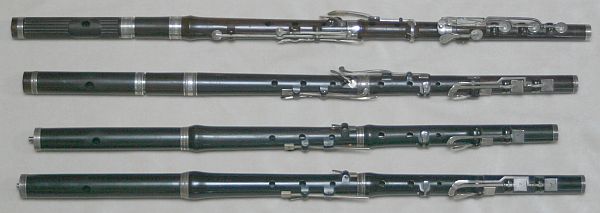
The earliest instrument of these four represents a common type of flute from the firm after 1812. This flute (#899, c.1813) has seven keys. Some English players thought the long F key unnecessary, though Monzani himself recommended nine keys—including the long F and an extra Bb key, which he specifically calls the eighth and ninth keys—in his flute method of 1813, as on #1748. Note that Monzani combined the foot joint and the lower center joint (patented in 1812, but used before that), so there are three sections to his flutes.

If you think you see four pieces, it is because there is a second head joint that I wasn't counting. Monzani supplied many of his earlier flutes with two head joints. This was in lieu of a corps de rechange. The two heads differ in length by about 5 mm and change the pitch by about 5 Hz. For me, the pitches that this instrument plays at are A=433 (with head joint stamped 2) and A=438 (with head joint stamped 1). A set of heads of different lengths is not as good a tuning device as a corps de rechange, but it works acceptably as when there are only two heads that do not differ greatly in length. Presumably in part because of this arrangement, Monzani flutes from this period usually have the feature that the head joints have the tenons and the center joint has the socket. The sockets are often lined with silver and covered with cork (patent of 1812).
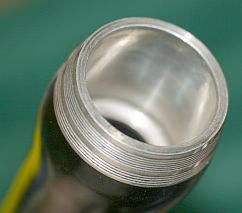

Top: #3049 (c.1830). Bottom: #899 (c.1813).
It is difficult to play medium or large hole flutes without the long F key. One must often quickly slide RH3 from the short F key to hole 6 or the other way—to go from F to Eb or D, or the other way. Monzani's design of the short F key makes this a bit easier. The touch of the short F is angled towards hole 6, and fits into an excavation in the body when depressed, so that part of it is level with the surface. This design is used on flutes #982, #1748, and #3049, but not #899. The photos below are of #1748. The first shows the short F from from the player side and the second from the audience side.
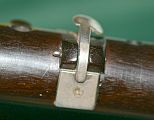
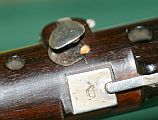
One can see in the second photo that #1748 does have a long F key, so the special touch to the short F key is not as important as on flutes without.
Sometime in the period 1815–1820, flutes of a somewhat different design began to come from Monzani's shop. These flutes were made with tuning heads and have a straight profile, without strengthening bulges at the sockets. (The straight profile would become fashionable in London; many Rudall & Rose flutes were made this way.) In spite of the tuning head, the head joint is almost always still provided with the tenon. The G# key is mounted at an angle. The acoustics seem different as well. The flute shown below has small holes and good high notes including an effortless high a''' and a usable c''''. It reminds me of some French flutes in its playing characteristics (sweet sound, easy high notes, not particularly powerful).

The Bb keys on this flute are shown below. On this flute, the "real" Bb key is the one with the touch for RH1, and the left hand thumb is given the extra lever.

The key for RH1 would have been used for the B/b/A trill and several other situations. The photo on the left below is a close-up (from beneath the flute) of the flap being raised by the thumb key (off screen, to the left), and on the right is a close-up of the flap being raised by the key for RH1 (off screen, to the right).


Monzani only partially lined his tuning heads with metal tubing, as the French often did. (There are other English makers who occasionally used a partially lined head, e.g. Gerock.) The appearance of the tuning barrel seems to suggest that it was not intended to be extracted very far, as the inner metal tubing is soon exposed (though it makes no acoustical difference that it can be seen). Shown are the heads of #1748 and #3049, with the barrles extended a bit. With the tuning barrels completely unextended, the two flutes play at A=440 and A=445 or so, respectively.
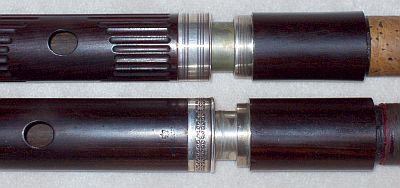
The key flaps of many Monzani flutes are provided with small threaded shafts and nuts to hold the pieces of leather to the flaps (rather than their being attached with sealing wax, a common method). The underside of the D# key of #899 is shown first below. The key flaps on #3049 have screws (see the second photo), but also are made in such a way that the round flaps can pivot and rotate a small amount (as on some French flutes of that time) to ensure better sealing.


Henry Hill, after he took over the business in 1829, continued to make similar flutes, of fine materials and high quality workmanship. He seems to have prefered the four piece construnction, with separate lower center and foot joint (though we show these two parts assembled, below). Some of his flutes have large holes, which was fashionable in London. Some of his flutes have B-foots and eleven or more keys, neither of which was particularly fashionable in London, although they were in Germany. The flute below would have been one of the finest from his shop. The headjoint is "fluted", which seems appropriate for a flute.

The silver keys and mounts on Monzani and Hill's flutes were generally hallmarked. The year in which this was done can be discerned from the markings, and this helps date the instrument. (But one must be careful, because keys may be made and then stored for years before being put on a flute. Serial numbers provide a second check.) The Hill flute #3049 has fairly clear marks, seen here on the shanks of the foot keys.
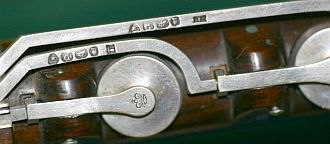
The most important part of the London hallmarks is the letter. The other symbols are a king's or queen's head, a lion passant, and a leopard's head. The capital 'A' was used in 1796–97, the capital 'B' was used in 1797–98, etc. (but SKIP 'J'), until the capital 'U' for 1815–16. Then the lower case 'a' for 1816–17, etc. (but SKIP 'j'), until the lower case 'u' for 1835–36. Upper case gothic letters for the next 20 years; and lower case gothic for the next.

So the lower case 'p' on #3049 means the keys were made in 1830–31.
Also see: Monzani flutes in the National Music Museum
